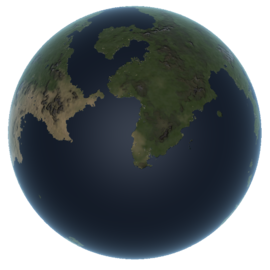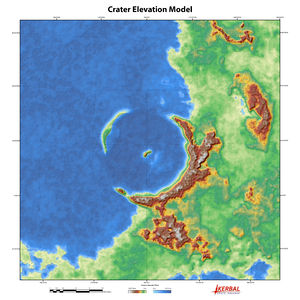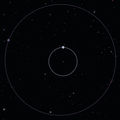Kerbin/ja
| カービン
(Kerbin) | ||
| 軌道からみたカービン | ||
| 惑星 周回 カーボル | ||
| 軌道の特徴 | ||
| 軌道長半径 | 13 599 840 256 m [Note 1] | |
| 軌道遠点 | 13 599 840 256 m [Note 1] | |
| 軌道近点 | 13 599 840 256 m [Note 1] | |
| 軌道離心率 | 0 | |
| 軌道傾斜角 | 0 ° | |
| 近点引数 | 0 ° | |
| 昇交点黄経 | 0 ° | |
| 平均近点角 | 3.14 rad (で 0秒 UT) | |
| 軌道周期 | 9 203 545 秒 | |
| 426 d 0 h 32 m 24.6 s | ||
| 会合周期 | 定義されていません | |
| 軌道速度 | 9 285 m/秒 | |
| 体格的特徴 | ||
| 赤道半径 | 600 000 m | |
| 赤道周長 | 3 769 911 m | |
| 表面積 | 4.5238934×1012 m2 | |
| 質量 | 5.2915158×1022 kg | |
| 標準重力パラメータ | 3.5316000×1012 m3/秒2 | |
| 密度 | 58 484.090 kg/m3 | |
| 表面重力 | 9.81 m/秒2 (1 g) | |
| 宇宙速度 | 3 431.03 m/秒 | |
| 恒星回転周期 | 21 549.425 秒 | |
| 5 h 59 m 9.4 s | ||
| 太陽の日 | 21 600.000 秒 | |
| 5 h 59 m 60 s | ||
| 恒星回転速度 | 174.94 m/秒 | |
| 同期軌道 | 2 863.33 km | |
| 作用圏 | 84 159 286 m [Note 1] | |
| 大気の特性 | ||
| 大気の有無 | はい | |
| 大気圧 | 101.325 kPa | |
| 1 atm | ||
| 大気圏高度 | 70 000 m | |
| 1.0×10-6 atm | ||
| 気温最低 | -86.20 °C 186.95 K | |
| 気温最高 | 15 °C 288.15 K | |
| 酸素存在 | はい | |
| サイエンスポイント倍率 | ||
| 着陸 | 0.3 | |
| 着水 | 0.4 | |
| 低空 | 0.7 | |
| 大気圏上層部 | 0.9 | |
| 低高度宇宙 | 1 | |
| 高高度宇宙 | 1.5 | |
| 回収 | 1 | |
|
| ||
Kerbinは緑たちの故郷であり、宇宙センターがある場所である。 そのためKerbal Space Programの主な舞台となっている。地球の類似星でもあり、 MunとMinmusという2つの衛星を持つ。
Kerbinは恒星Kerbolを周回する第3惑星である。 Kerbolを周回する天体としてはJoolとEveについで3番目に大きい。 Joolの衛星TyloはKerbinと半径が同じだが、最高地点が約5 km高いので、Tyloの方が大きな天体として分類されている。 しかし、Tyloの質量はKerbinのたった80%しかない。 安定した軌道にのることは、このゲームでプレイヤーが達成する最初のマイルストーンだろう。 燃料最適上昇 [1] では≈4500 m/sのdelta-vが必要とされ [2] 、これはEveについで2番目に高い値である。 多くの惑星間ミッションでは、その半分以上のdelta-VがKerbinの軌道到達に消費される。 地球からの惑星間フライトにおいても同様であり、ある観察者曰く:
| 「 | 軌道にのることができたら、何処へ行こうと、もう半分着いたようなものだ。 — ロバート・ハインライン, ジェリー・パーネル『A Step Farther Out』194ページより |
」 |
Contents
ゲーム内の説明
| 「 | 独特の世界。Kerbinには平らな大地、そびえ立つ山々、広く青い海がある。
Kerbalたちの故郷であり、頑張り屋で緑色をした生物の、その無尽蔵な人口を支えるには持ってこいの環境だ。 安定した軌道に達することは、宇宙開発の最初の難関である。船を軌道に載せることができたら、どこへでも半分来たようなものだと言われている。 — Kerbal天文学会 |
」 |
地勢
Kerbin has a roughly equal distribution of surface liquid water and solid land, with polar icecaps and scattered deserts. Some of its mountains exceed 6 km in height, with the tallest peak being 6761 m in altitude around the coordinates 46.4° E 61.6° N. The lowest is almost 1.4 km deep and about 313° south-west of the Kerbal Space Center.
Craters
Unlike other bodies in its system, Kerbin has few visible craters because its environment would erode craters from the few meteors that avoid the gravity or surface of its large moon and survive entry. Nevertheless, some geological formations indicate that bodies have violently collided with Kerbin: two planetary features appear to be impact craters that are coincidentally separated by nearly 180 degrees. The least eroded, and therefore presumably youngest, of the two (both are in excess of 100 km diameter) lies along the coastline. The uplift is easily visible as a series of islands, and the feature has a central peak that pokes up through the water (also known as a rebound peak.) The other, and older of the two, is near the prime meridian in the northern hemisphere and is more easily missed, but its uplift rims are visible, and it has a central rebound peak.
Biomes
One of the few bodies with multiple biomes, Kerbin is second only to the Mun in how many it has. Science experiments can be performed at all biomes, though Kerbin's low multipliers result in less impressive results than more distant worlds. Kerbin's biomes show a loose correlation with Earth's biomes and geographic features. Uniquely, Kerbin has three special location biomes comprised of KSC's grounds; these give a jumpstart to gathering Science points in Career mode.
Atmosphere
Kerbin's atmosphere contains oxygen and extends to roughly 69,078 meters. Its atmosphere exponentially rarefies with altitude with a scale height of 5 km.[3] The atmospheric pressure on Kerbin at an altitude expressed in meters, generally is:
The thickness of Kerbin's atmosphere makes it suitable for aerobraking and using parachutes to save fuel during reentry and landing. Since バージョン 0.19, harmless supersonic and shock heating/reentry effects have been applied to objects flying above certain velocities. Debris flying in the lower atmosphere disappears once 2 km from an active craft, but above approx. 23 km debris persists. Spent stages may continue in a stable orbit even if they are going through thick atmosphere that would destabilize the orbit of an active craft[outdated].
The following table gives approximation of terminal velocities at different Kerbin altitudes, which are also the velocities at which a ship should travel for a fuel-optimal vertical ascent from Kerbin, given the game's model of atmospheric drag.[4] The optimal velocity after a gravity turn has been started is less than the corresponding value in the table.[5]
| Altitude (m) | Velocity (m/s) |
|---|---|
| 75 | 100.8 |
| 1000 | 109.3 |
| 2000 | 119.3 |
| 3000 | 130.2 |
| 4000 | 142.2 |
| 5000 | 155.2 |
| 6000 | 169.4 |
| 7000 | 184.9 |
| 8000 | 201.8 |
| 9000 | 220.3 |
| 10000 | 240.5 |
| 12500 | 299.4 |
| 15000 | 372.8 |
| 20000 | 577.9 |
| 32000 | 1655.1 |
Orbits
A synchronous orbit is achieved with a semi-major axis of 3 463.33 km. Kerbisynchronous Equatorial Orbit (KEO) has a circularly uniform altitude of 2 863.33 km and a speed of 1 009.81 m/秒. From a 70 km low equatorial orbit, the periapsis maneuver requires 676.5 m/s and the apoapsis maneuver requires 434.9 m/s. A semi-synchronous orbit with an orbital period of ½ of Kerbin's rotation period (2 h 59 m 34.7 s or 10774.7 seconds) is achieved at an altitude of 1 581.76 km with an orbital velocity of 1 272.28 m/秒.
The Hill sphere (the radius around the planet at which moons are gravitationally stable) of Kerbin is 136 185 km, or roughly 227 Kerbin radii.
Interplanetary Travel
From the lowest stable orbit around Kerbin (70 km), the amount of delta-V needed to reach the orbits of other celestials is:
| Body | Delta-V |
|---|---|
| Mun | ~860 m/s |
| Minmus | ~930 m/s |
| Eve | ~1033 m/s |
| Duna | ~1060 m/s |
| Moho | ~1676 m/s |
| Jool | ~1915 m/s |
| Eeloo | ~2100 m/s |
| KEO (comparison) | ~1120 m/s |
Reference Frames
| 時間加速中 | 最低高度 |
|---|---|
| 1× | どこでも |
| 5× | 70 000 m (大気圏以上) |
| 10× | 70 000 m (大気圏以上) |
| 50× | 70 000 m (大気圏以上) |
| 100× | 120 000 m |
| 1 000× | 240 000 m |
| 10 000× | 480 000 m |
| 100 000× | 600 000 m |
Gallery
Topographical map of Kerbin as of バージョン 0.21
A projection map of Kerbin, as of 0.14.1 and before (including the old demo).
Topographical image of Kerbin from 0.17.1. The terrain is slightly different in the latest version.[6]
Changes
- Rotational speed changed so solar day is now 6 hours (previously sidereal day was 6 hours). (Rotation speed not actually changed)
- Biomes added.
- Terrain revised to produce more detailed and interesting landforms.
- Fixed ladders on the fuel tanks near the launchpad.
- New mesh for the launchpad and area (no launchtower anymore).
- New mesh for the runway, with lights and sloping edges for rovers.
- Terrain overhaul: Entire planet redo. Deserts, darker and greener grass, islands, darker ocean/water, snow capped mountains. Looks more realistic.
- Several Easter Eggs added.
- Airport added to island off of KSC coastline. (Not a launching point)
- Improved atmosphere visuals.
- Minmus added.
- Much more varied and taller terrain added. Prior to this, some mountain ranges exceeded 600 m in height, but the tallest point was at an altitude of approximately 900 m.
- Mün added.
- Terrain overhaul, oceans became wet.
- Atmosphere extended from ~34,500 m to ~69,000 m.
- Initial Release
Trivia
Kerbin's continents are derived from libnoise,[7] a coherent noise generating library, though they have been increasingly modified with time.
Notes
- ↑ 燃料最適上昇とは(a)重力と空気抵抗による速度の低減を最小限にし、 (b)東(方位90度)に向かって打ち上げることで、Kerbinの自転の力によって軌道速度174.5 m/sを得ることである。
- ↑ this challenge on the forum と、 Kerbin delta-V chartを参照。
- ↑ Forum thread 16000, "[KGSS] Examining Kerbin's atmosphere"
- ↑ http://forum.kerbalspaceprogram.com/showthread.php/6664-Mini-challenge-max-altitude-with-this-supplied-spacecraft?p=100912&viewfull=1#post100912
- ↑ http://www.reddit.com/r/KerbalSpaceProgram/comments/1kov5z/a_handy_chart_i_made_for_the_most_efficient/cbrdvuo
- ↑ http://forum.kerbalspaceprogram.com/entry.php/247-A-Brave-New-World
- ↑ http://libnoise.sourceforge.net/examples/complexplanet/





















